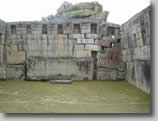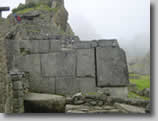Machu Picchu Architecture

The architecture used in order to create Machu Picchu was exrtaordinary considering that it was built around the 15th Century and also the location of the build which is 2,430 meters above sea level and situated on a ridge in the Andean mountain region. Machu Picchu is constructed by using dry-stone walls of varying shape with blocks of stone cut precisely so that they can fit together tightly without having to use any form of mortor in order to keep the walls standing. With the majority of Machu Piccuh created using this technique it displays the excellent craftsmanship of the Inca people and how they had mastered the building technique called ashlar.
Throughout Machu Picchu the buildings are mostly one-storey high andinclude typical features such as rectangular constructions with trapezoidal doors and windows. Mortar-freeconstruction was more earthquake-resistant than using mortar and subtle design techniques suchas corners are usually rounded, inside corners often incline slightly into the rooms, and "L" shaped blocks are often used to tie outside corners together. Walls do not rise straight from top to bottom but are offset slightly from row to row and all of which has added to the longevity of the inca ruins. The quality of the Inca build is demonstrated by the fact it still remains standing considering that Peru has had to endure many earthquakes over the time Machu Picchu has stood.

Another factor that must be taken into consideration is that there is no evidence of the Inca civilisation using the wheel in order to move the giant granite blocks they have used to create Machu Picchu. Although the round shape had been created they have not discovered the ability to apply the round shape into a wheel. It is unknown how the Incas managed to move the stones, although it is believed that the stones were moved by thousands of men to push the stones around the Machu Picchu site. It is also believed that the stones were levered into position and the levers were then sanded away.
The original builders of Machu Picchu worked hard to obtain an architectural balance in a special and difficult place. They even used materials found nearby to adapt the buildings to several levels. There are two large sections: the agricultural sector on the south and the urban sector on the north. Both have been constructed on top of a natural division, taking advantage of the existence of a dry pit, the result of a geologic fault that runs through the centre of Machu Picchu.

